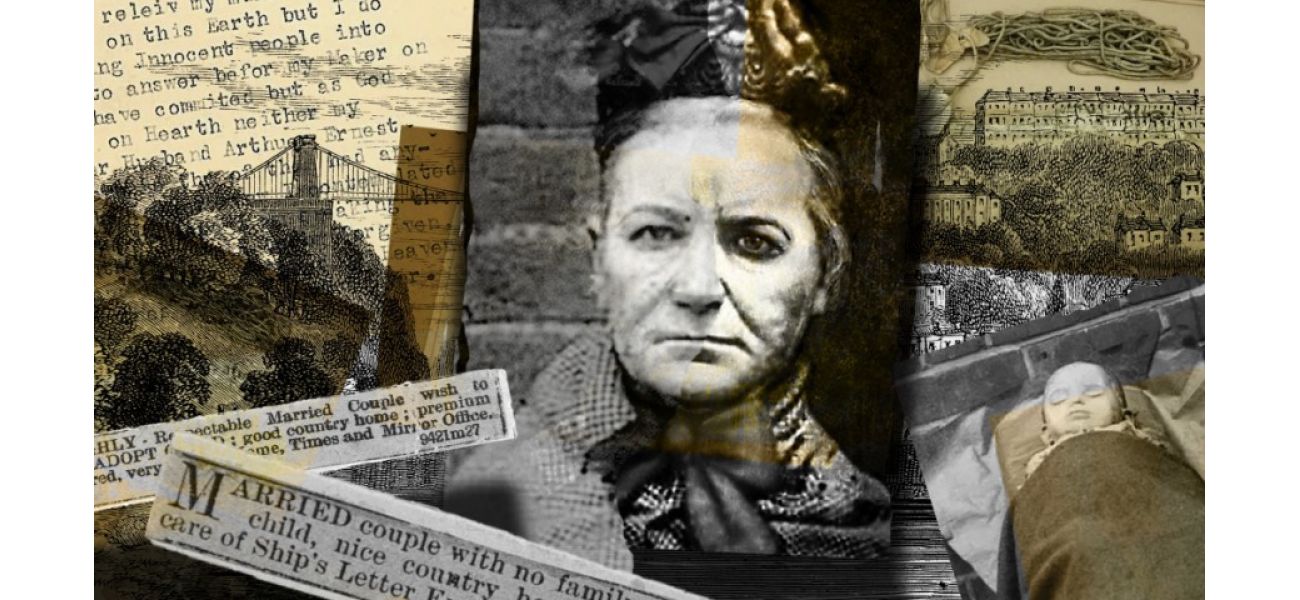Notorious female murderer from Britain, unknown to the public.
A 'baby farmer' in Victorian era killed kids for over 25 years
September 2nd 2024.

Amelia Dyer was a notorious figure in the Victorian era, known for her heinous crimes as a 'baby farmer.' She was responsible for the deaths of hundreds of innocent babies over a period of 25 years. It is hard to imagine how someone could commit such atrocities, but the truth is that Dyer was a cunning and manipulative woman, who took advantage of the societal norms and prejudices of her time.
Her modus operandi was simple yet devious. Dyer would place an advertisement in the newspaper, posing as a respectable and wealthy couple seeking to adopt a child. Her ad read, "Highly respectable married couple wish to adopt a child; good country home; premium required, very small." On the surface, it seemed like a genuine offer, but in reality, Dyer had no husband, no grand home, and certainly no intention of providing a loving home for any child.
As a 'baby farmer,' Dyer's main target was unmarried mothers who were shunned by society and had no means to support their child. In the Victorian era, having a child out of wedlock was considered a grave sin, and women who found themselves in this situation were often ostracized. Dyer took advantage of this and offered to take care of the unwanted child for a fee of £10, which was a considerable sum at the time.
Dyer's background as a nurse gave her the perfect cover for her nefarious activities. She would take in the babies and promise to care for them while their mothers could get back on their feet. But instead of providing love and care, Dyer would brutally murder the infants and pocket the money. Her methods were cruel and heartless, as she would strangle the babies with ribbons or administer lethal doses of opiate-laced medicine.
Joel Briggs, the curator of the True Crime Museum, described Dyer's 25-year reign of terror as a "career of killing children." He revealed that in the early days, Dyer would kill the babies before they were even born, strangling them while they were still in the womb. But as she grew older, she became more brazen and would wait until the child was a few weeks old before killing them.
Dyer's actions went unnoticed for years, as adoption services were not regulated at the time. But eventually, her crimes were exposed when a bargeman found the body of a baby in the Thames. The police traced the body back to Dyer, and she was finally arrested and put on trial.
It was during the trial that the full extent of Dyer's evil deeds came to light. She had moved from place to place, using different names to avoid suspicion. But her fake 'adoption services' always followed the same pattern – luring in vulnerable mothers with false promises and then killing their babies.
Dyer's case caused a sensation in the press, and she was dubbed the 'Ogress of Reading.' It also brought to light the dark world of baby farming and the need for stricter regulations to protect newborns. The Infant Life Protection Act and the Children's Act were passed as a result, bringing an end to the practice of baby farming.
Today, Dyer's bodice is displayed at the True Crime Museum, serving as a grim reminder of the horrors she committed. Some may wonder what drove Dyer to such wickedness, and some have even expressed sympathy for her, citing the strict societal norms and the illegality of abortion at the time. But as Joel points out, there can be no forgiveness for what Dyer did, and her crimes were a product of the toxic and hypocritical society of the Victorian era.
Amelia Dyer was a woman who lived in the Victorian era and was known for her heinous crimes. She was a 'baby farmer' which was a term used to describe women who took in unwanted babies for a fee, and either neglected or killed them. It was a time when having a baby outside of marriage was highly frowned upon and women who found themselves in such a situation were often ostracized by society. Dyer took advantage of this and advertised her services in newspapers, claiming to be a 'highly respectable' woman looking to adopt a child. However, the truth was far from it.
She had no husband, no grand home, and was not a respectable woman by any means. Her only intention was to kill as many babies as she could get her hands on. Dyer's modus operandi was to lure new mothers by offering to take care of their babies for a fee. She would meet them at train stations and charge them £10, which was a considerable amount at that time, to look after their child. But instead of taking care of the babies, she would brutally murder them and pocket the money.
Joel Briggs, the curator of the True Crime Museum in Hastings, East Sussex, explains that Dyer had a career spanning 25 years, during which she killed hundreds of children. In the early days, she would strangle the babies as soon as they were born, before they even took their first breath. As she grew older, she became bolder and would use various methods such as suffocation and poisoning with a medicine called Godfrey's Cordial, also known as 'Mother's Friend', to kill the babies. She would then wrap their bodies in paper and throw them into the Thames or Avon river.
Dyer managed to get away with her crimes for many years because there were no regulations or checks on adoption services at that time. She also frequently changed her name and moved from one city to another, making it difficult for the authorities to track her down. But eventually, her evil deeds caught up with her when a bargeman discovered the body of a baby in the Thames. The police traced the body back to Dyer's address and arrested her.
During her trial, it emerged that Dyer had been a nurse and had turned to baby farming after being widowed in 1869. She had three children of her own, but it is suspected that her daughter and son-in-law were also involved in her crimes. Dyer pleaded insanity, but the jury saw through her act and found her guilty of murder. She was sentenced to death and hanged at Newgate prison.
Joel recalls a heartbreaking incident during the investigation, when the police found ten dead babies in the river, out of which only six were linked to Dyer. This shows how common it was for unwanted babies to be killed during that time. The case gained a lot of media attention and Dyer was given the nickname 'Ogress of Reading.' Her actions also shed light on the issue of baby farming and led to the passing of laws to protect newborns.
Today, many visitors to the True Crime Museum express sympathy for Dyer, believing that she was forced to carry out her crimes because abortion was illegal during that time. However, Joel believes that while the social context of that era played a role, it cannot justify her actions. He also points out the hypocrisy and double standards of the Victorian society, which looked down upon women who had children outside of marriage, but turned a blind eye to the actions of women like Dyer who pretended to be respectable and godly.
Amelia Dyer's story is a reminder of the dark and murky world of baby farming, where innocent lives were taken for profit. Thanks to her crimes, stricter regulations were put in place to protect newborns, ultimately putting an end to the practice of baby farming. The True Crime Museum still displays Dyer's bodice and other items related to her case, serving as a reminder of the horrific crimes she committed.
Her modus operandi was simple yet devious. Dyer would place an advertisement in the newspaper, posing as a respectable and wealthy couple seeking to adopt a child. Her ad read, "Highly respectable married couple wish to adopt a child; good country home; premium required, very small." On the surface, it seemed like a genuine offer, but in reality, Dyer had no husband, no grand home, and certainly no intention of providing a loving home for any child.
As a 'baby farmer,' Dyer's main target was unmarried mothers who were shunned by society and had no means to support their child. In the Victorian era, having a child out of wedlock was considered a grave sin, and women who found themselves in this situation were often ostracized. Dyer took advantage of this and offered to take care of the unwanted child for a fee of £10, which was a considerable sum at the time.
Dyer's background as a nurse gave her the perfect cover for her nefarious activities. She would take in the babies and promise to care for them while their mothers could get back on their feet. But instead of providing love and care, Dyer would brutally murder the infants and pocket the money. Her methods were cruel and heartless, as she would strangle the babies with ribbons or administer lethal doses of opiate-laced medicine.
Joel Briggs, the curator of the True Crime Museum, described Dyer's 25-year reign of terror as a "career of killing children." He revealed that in the early days, Dyer would kill the babies before they were even born, strangling them while they were still in the womb. But as she grew older, she became more brazen and would wait until the child was a few weeks old before killing them.
Dyer's actions went unnoticed for years, as adoption services were not regulated at the time. But eventually, her crimes were exposed when a bargeman found the body of a baby in the Thames. The police traced the body back to Dyer, and she was finally arrested and put on trial.
It was during the trial that the full extent of Dyer's evil deeds came to light. She had moved from place to place, using different names to avoid suspicion. But her fake 'adoption services' always followed the same pattern – luring in vulnerable mothers with false promises and then killing their babies.
Dyer's case caused a sensation in the press, and she was dubbed the 'Ogress of Reading.' It also brought to light the dark world of baby farming and the need for stricter regulations to protect newborns. The Infant Life Protection Act and the Children's Act were passed as a result, bringing an end to the practice of baby farming.
Today, Dyer's bodice is displayed at the True Crime Museum, serving as a grim reminder of the horrors she committed. Some may wonder what drove Dyer to such wickedness, and some have even expressed sympathy for her, citing the strict societal norms and the illegality of abortion at the time. But as Joel points out, there can be no forgiveness for what Dyer did, and her crimes were a product of the toxic and hypocritical society of the Victorian era.
Amelia Dyer was a woman who lived in the Victorian era and was known for her heinous crimes. She was a 'baby farmer' which was a term used to describe women who took in unwanted babies for a fee, and either neglected or killed them. It was a time when having a baby outside of marriage was highly frowned upon and women who found themselves in such a situation were often ostracized by society. Dyer took advantage of this and advertised her services in newspapers, claiming to be a 'highly respectable' woman looking to adopt a child. However, the truth was far from it.
She had no husband, no grand home, and was not a respectable woman by any means. Her only intention was to kill as many babies as she could get her hands on. Dyer's modus operandi was to lure new mothers by offering to take care of their babies for a fee. She would meet them at train stations and charge them £10, which was a considerable amount at that time, to look after their child. But instead of taking care of the babies, she would brutally murder them and pocket the money.
Joel Briggs, the curator of the True Crime Museum in Hastings, East Sussex, explains that Dyer had a career spanning 25 years, during which she killed hundreds of children. In the early days, she would strangle the babies as soon as they were born, before they even took their first breath. As she grew older, she became bolder and would use various methods such as suffocation and poisoning with a medicine called Godfrey's Cordial, also known as 'Mother's Friend', to kill the babies. She would then wrap their bodies in paper and throw them into the Thames or Avon river.
Dyer managed to get away with her crimes for many years because there were no regulations or checks on adoption services at that time. She also frequently changed her name and moved from one city to another, making it difficult for the authorities to track her down. But eventually, her evil deeds caught up with her when a bargeman discovered the body of a baby in the Thames. The police traced the body back to Dyer's address and arrested her.
During her trial, it emerged that Dyer had been a nurse and had turned to baby farming after being widowed in 1869. She had three children of her own, but it is suspected that her daughter and son-in-law were also involved in her crimes. Dyer pleaded insanity, but the jury saw through her act and found her guilty of murder. She was sentenced to death and hanged at Newgate prison.
Joel recalls a heartbreaking incident during the investigation, when the police found ten dead babies in the river, out of which only six were linked to Dyer. This shows how common it was for unwanted babies to be killed during that time. The case gained a lot of media attention and Dyer was given the nickname 'Ogress of Reading.' Her actions also shed light on the issue of baby farming and led to the passing of laws to protect newborns.
Today, many visitors to the True Crime Museum express sympathy for Dyer, believing that she was forced to carry out her crimes because abortion was illegal during that time. However, Joel believes that while the social context of that era played a role, it cannot justify her actions. He also points out the hypocrisy and double standards of the Victorian society, which looked down upon women who had children outside of marriage, but turned a blind eye to the actions of women like Dyer who pretended to be respectable and godly.
Amelia Dyer's story is a reminder of the dark and murky world of baby farming, where innocent lives were taken for profit. Thanks to her crimes, stricter regulations were put in place to protect newborns, ultimately putting an end to the practice of baby farming. The True Crime Museum still displays Dyer's bodice and other items related to her case, serving as a reminder of the horrific crimes she committed.
[This article has been trending online recently and has been generated with AI. Your feed is customized.]
[Generative AI is experimental.]
0
0
Submit Comment





